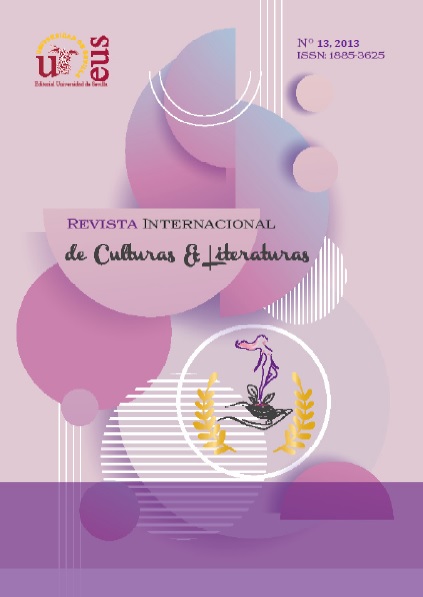‘NO-BODY’: ENVEJECIMIENTO PREMATURO Y AUSENCIA CORPORAL FEMENINA EN “PERSUASION” DE JANE AUSTEN
Palabras clave:
cuerpo, identidad, ausencia, sufrimiento, envejecimiento, suicidioResumen
La presencia de incógnito de Jane Austen en el panorama literario del siglo XIX armoniza con la ausencia del “no-cuerpo” de Anne, su heroína en Persuasion que, con o sin freno narrativo, se repliega hacia sí misma y pierde sus demarcaciones identitarias con desembocadura textual en envejecimiento prematuro, el estigma de la “solterona” y su deshumanización en un entorno hostil que acelera su anulación física y psíquica.
Abstract
The incognito presence of Jane Austen in the literary scene of the 19th century harmonizes with the absence of the “non-body” of Anne, her heroine in Persuasion who, with or without narrative brake, withdraws towards herself and loses her identity demarcations with textual culmination in premature aging, the stigma of the "spinster" and her dehumanization in a hostile environment that accelerates her physical and mental annulment.
Descargas
Citas
Arendt, H., The Human Condition, Chicago, University of Chicago Press, 1958.
Astell, A. W., “Anne Elliot’s Education: The Learning of Romance in Persuasion”, Renascence 40, 1 (1987), pp. 2-14.
Austen, J., Sense and Sensibility, ed. Ros Ballaster, Londres, Penguin, 1811
Austen, J., Pride and Prejudice, ed. Vivien Jones, Londres, Penguin, 1813.
Austen, J., Persuasion, ed. Patricia Meyer Spacks, Nueva York, Norton, 1817.
Austen, J., Jane Austen’s Letters to her Sister Cassandra and Others, ed. Robert William Chapman, Oxford, Oxford University Press, ed. 1952.
Baker, W., Critical Compation to Jane Austen: A Literary Reference to Her Life and Work, Nueva York, Facts on File, 2008.
Beauvoir, S., Le deuxième sexe, vol. I: Les faits et les mythes, Paris, Gallimard, 1949.
Benditt, T. M., “The Virtue of Pride: Jane Austen as Moralist”, The Journal of Value Enquiry 37, 1 (2003), pp. 245-57.
Butler, M., Jane Austen and the War of Ideas, Nueva York, Oxford University Press, 1987.
Chandler, A., “A Pair of Fine Eyes: Jane Austen’s Treatment of Sex”, Studies in the Novel 7, 1 (1975), pp. 88-103.
Clarke, E. H., Sex in Education; or, a Fair Chance for the Girls, Boston, James R. Osgood & Co, 1873.
Durkheim, É., Le suicide: Étude de sociologie, Paris, Presses Universitaires de France, 1897.
Ellis, T. E., “The Study of Cognition and Suicide: Beginnings and Developmental Milestones”, Cognition and Suicide: Theory, Research, and Therapy, ed. Thomas E. Ellis, Washington, American Psychological Association, 2006.
Freud, S.,“Lecture XXXIII: On Femininity”, New Introductory Lectures on Psychoanalysis, ed. James Strachey, Nueva York, Norton, 1933, pp. 134-45.
Gilbert, S. M. y S. Gubar, The Madwoman in the Attic: The Woman Writer and the Nineteenth Century Literary Imagination, New Haven, Yale University Press, 1979.
Hayley, W., “A Philosophical, Historical, and Moral Essay on Old Maids”, Persuasion de Jane Austen, ed. Patricia Meyer Spacks, Nueva York, Norton, 1785.
Ingham, P., The Brontës, Oxford, Oxford Universty Press, 2006.
Johnson, C. L., “Persuasion: The Unfeudal Tone of Present Day”, Jane Austen: Women, Politics, and the Novel, Chicago, University of Chicago Press, 1988.
Lynch, D. S., “Young Ladies are Delicate Plants: Jane Austen and Greenhouse Romanticism”, English Literary History 77, 3 (2010), pp. 689-729.
Moers, E., Literary Women, Londres, Women’s Press, 1963.
Pinch, A., “Lost in a Book: Jane Austen’s Persuasion”, Studies in Romanticism 32, 1 (1993), pp. 97-117.
Richardson, A., “Of Heartache and Head Injury: Reading Minds in Persuasion”, Poetics Today 23, 1 (2002), pp. 141-60.
Showalter, E., A Literature of their Own: British Women Writers from Charlotte Brontë to Doris Lessing, Londres, Virago, 1977.
Showalter, E.,. The Female Malady: Women, Madness and English Culture, 1830-1980, Londres, Virago, 1985.
Tanner, T., Jane Austen, Cambridge, Harvard University Press, 1986.
Wilkes, J., “Song of the Dying Swan? The Nineteenth Century Response to Persuasion”, Studies in the Novel 28, 1 (1996), pp. 38-56.
Woolf, V., “Jane Austen”, The Common Reader, vol. I, Nueva York, Harcourt, 1925.
Wiltshire, J., “Mansfield Park, Emma, Persuasion”, The Cambridge Companion to Jane Austen, eds. Edward Copeland y Juliet McMaster, Cambridge, Cambridge University Press, 2006.
Wingate, L. R., et al., “Suicide and Positive Cognitions: Positive Psychology Applied to the Understanding and Treatment of Suicidal Behavior”, Cognition and Suicide: Theory, Research, and Therapy, ed. Thomas E. Ellis, Washington, American Psychological Association, 2006.
Young, K., “Feeling Embodied: Consciousness, Persuasion and Jane Austen”, Narrative 11, 1 (2003): pp. 78-92.

